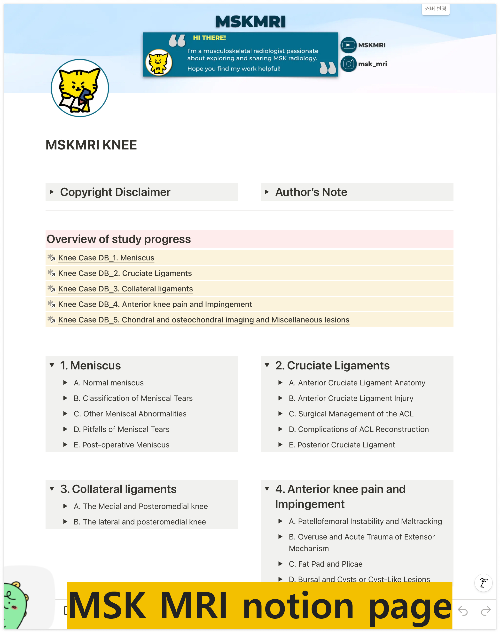👉 Click the link below and request access—I’ll approve it for you shortly!
https://www.notion.so/MSKMRI-KNEE-b6cbb1e1bc4741b681ecf6a40159a531?pvs=4
==============================================
✨ Join the channel to enjoy the benefits! 🚀
https://www.youtube.com/channel/UC4bw7o0l2rhxn1GJZGDmT9w/join
==============================================
👉 "Click the link to purchase on Amazon 🎉📚"
[Visualizing MSK Radiology: A Practical Guide to Radiology Mastery]
https://www.amazon.com/dp/B0DJGMHMFS
==============================================
MSK MRI Jee Eun Lee
📚 Visualizing MSK Radiology: A Practical Guide to Radiology Mastery Now! 🌟 Available on Amazon, eBay, and Rain Collectibles! 💻 Ebook coming soon – stay tuned! ⏳ 🔗 https://www.amazon.com/dp/B0DJGMHMFS 🔗 https://www.ebay.com/itm/3875004193
www.youtube.com
Visualizing MSK Radiology: A Practical Guide to Radiology Mastery
www.amazon.com
📌 Differential Diagnosis of Osteochondritis Dissecans
- Osteochondral defects can present in various forms and distinguishing between them is crucial for accurate diagnosis and treatment.
- This overview summarizes the key features of several conditions that can mimic or be confused with osteochondritis dissecans (OCD).
1️⃣ Osteochondritis Dissecans (OCD)
Mechanism: “Inside-out”
- OCD is characterized by a chronic osteochondral lesion occurring in children and young adults, specifically in classic locations.
- The hallmark of OCD is the separation and detachment of the osteochondral fragment.
- This process begins deep underneath the articular surface and subsequently involves the articular cartilage at the peripheral border of the lesion, following an “inside-out” mechanism.
2️⃣ Acute Traumatic Osteochondral Injury
Mechanism: “Outside-in”
- This condition begins with damage to the articular cartilage, which, if subjected to sufficient force, progresses to disrupt the subchondral bone, demonstrating an “outside-in” mechanism.
3️⃣ Subchondral Insufficiency Fracture (SIF)
- SIFs often occur associated with meniscal tears in the same compartment in 76%–94% of patients, with more than 50% demonstrating radial and posterior root tears.
- Case: On fluid-sensitive imaging, SIFs appear as abnormal areas of fluid-like linear hyperintensity that undermine and separate the subchondral bone plate from the rest of the epiphysis.
References
- RadioGraphics 2018; 38:1478–1495
- AJR 2019; 213:963–982
"Visualizing MSK Radiology: A Practical Guide to Radiology Mastery"
© 2022 MSK MRI Jee Eun Lee All Rights Reserved.
No unauthorized reproduction, redistribution, or use for AI training.
#OsteochondritisDissecans, #OsteochondralDefects, #Radiology, #Musculoskeletal, #Orthopedics, #SportsInjuries, #Imaging, #SubchondralFracture, #AcuteInjury, #MRI
'✅ Knee MRI Mastery > Chap 5AB. Chondral and osteochondral' 카테고리의 다른 글
| (Fig 5-B.28) Four Types of Subchondral Insufficiency Fractures (1) | 2024.07.14 |
|---|---|
| (Fig 5-B.27) Types of Ossification Variants of the Knee (0) | 2024.07.13 |
| (Fig 5-B.25) Signs of Osteochondral Lesion Instability in Juveniles (0) | 2024.07.13 |
| (Fig 5-B.24) Signs of Osteochondral Lesion Instability in Adults (0) | 2024.07.13 |
| (Fig 5-B.23) ICRS Staging System of Osteochondritis Dissecans (0) | 2024.07.13 |






